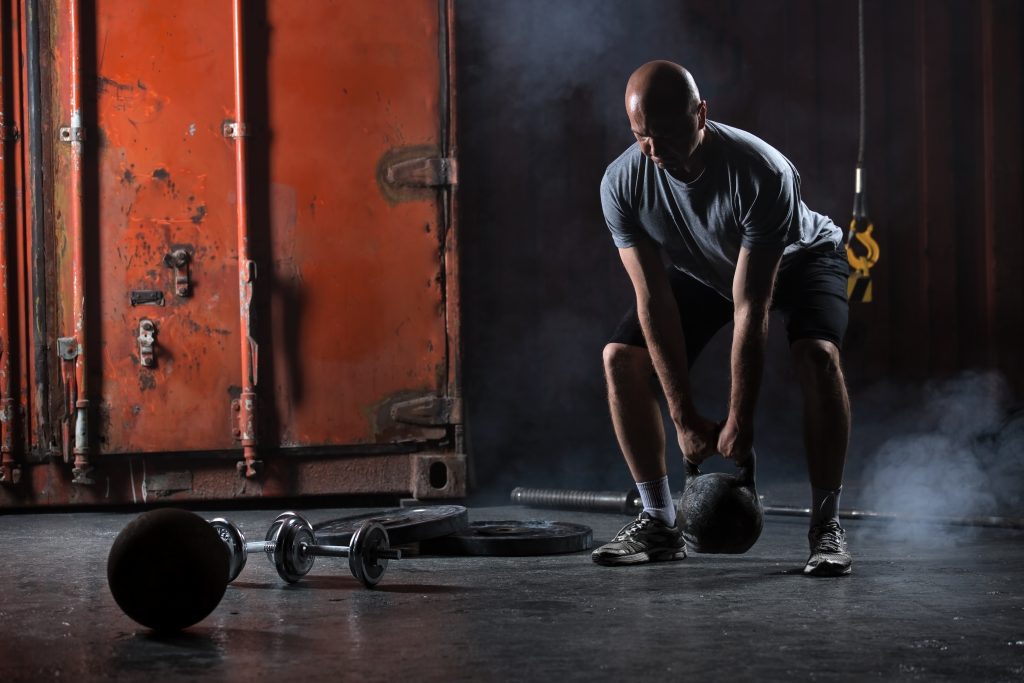Exercises You Should Be Doing: Band Resisted Kettlebell Deadlift
One of my biggest pet peeves about the fitness industry are those people who tend to be absolutists about stuff.
They feel that just because something worked for them that it must mean it’ll apply to everyone, and you’re an idiot or inept if you feel otherwise:
- You have to back squat if you want to get strong.
- You have to follow a Paleo diet if you want to get ripped.
- You have to wear pants when you’re training clients.
It’s all a bunch of hooey if you ask me. Nothing is set in stone, and nothing is going to apply across the board towards a diverse population with varying injury histories, goals, and ability levels.
This train of thought applies towards the deadlift as well.

Copyright: bezikus / 123RF Stock Photo
There aren’t many exercises as maligned or misrepresented as the deadlift.
On an almost weekly basis I’m having a conversation with someone who offhandedly says “so and so mentioned to me how deadlifts are dangerous,” or “such and such said deadlifts are the worst thing ever for your back,” or “I heard deadlifts give you gonorrhea, is that true?”
Listen, deadlifts are no more “dangerous” than any other exercise that’s performed incorrectly (or with too much load/volume that surpasses any one individual’s threshold to recover from).
When performed well, and with the appropriate progressions in place, the deadlift is one of the best bang-for-your-training-buck exercises out there.
It’s also pretty freakin versatile.
Another popular fallacy of the deadlift is that it has to be performed with a straight bar, and that it has to be heavy.
Nothing could be further from the truth.
Picking anything up off the ground – whether it’s a barbell, dumbbell, a bag of groceries, a baby, or Mjolnir – with the knees slightly bent, hips flexed, and with an upright torso, can be considered a deadlift.
Not so dangerous now, huh?
To prove my point check out this gem of a variation.
Band Resisted KB Deadlift
Who Did I Steal It From? – Strength & Conditioning legend, Vince McConnell.
What Does It Do? – I had my client, Jessica (who’s in the video above), perform this last night because we’ve been working on troubleshooting through some hip shenanigans.
To put it bluntly, Jessica is strong AF.
Her best deadlift is 350 lbs with a straight bar, and I’m pretty sure she’s undefeated in Fight Club. Thing is, though, she’s always had trouble feeling her glutes during a deadlift.
As with most people, she’s gotten really good at compensating, and every now and again she’ll get a bit of a back niggle.
Not necessarily an injury; but, you know, just an annoying “something.”
This exercise serves a few purposes:
- Using a KB – so her center of mass is OVER the load – makes this exercise infinitely more “back friendly.”
- Adding the band takes advantage of accommodating resistance where the load gets more challenging at a position where she’s strongest (terminal hip extension).
- Too, adding the band, really helps with engaging the glutes to a higher degree at the top of the movement. I don’t know how better else to explain it other than “IT JUST DOES ALRIGHT. WHY DO YOU ALWAYS HAVE TO QUESTION ME?”
Key Coaching Cues – All I did was wrap a Jump Stretch band across two pegs at the bottom of my power rack and then loop the same band underneath the handle of a kettlebell.
Then Jessica lifted it.
And then it was Glute O’clock.
Normally I’m not a fan of high(er) rep deadlifts, but this variation lends itself to me breaking that rule.
Try 3-4 sets of 8-12 repetitions.



Comments for This Entry
For the Dead-Serious Lifter: Rogue Ohio Deadlift Bar vs. Texas Deadlift Bar
[…] Editor’s Note – Cody Martin also did a review of his Rogue Deadlift Bar by itself. David Kiesling did a comparison of these two bars plus the lesser-known Okie. Tony Gentilcore has a great article on an alternative exercise, band-resisted kettlebell deadlifts. […]December 6, 2018 at 7:29 pm |
Basic Floor-Bolted Power Racks Comparison – Rogue R-3 & R-4 vs Titan T-3
[…] Plus, you get to do band-resisted exercises without worrying about accidentally lifting your rack up, including weird stuff like the band resisted kettlebell deadlift. […]December 8, 2018 at 6:38 pm |
Will
Out of interest, what preventative work are you doing with Jessica for her niggles?December 10, 2018 at 10:09 am |